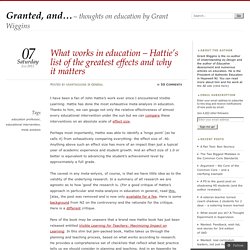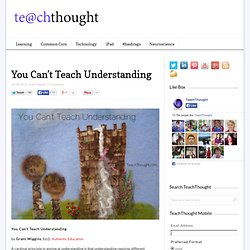

AfL%20Learning%20int%20and%20criteria. Goals. The+Main+Idea+-+Visible+Learning+for+Teachers+-+April+2013. What works best. This page has now been revised (May 2010) in the light of John Hattie's recent apparently definitive work Visible Learning; a synthesis of over 800 meta-analyses relating to achievement (London; Routledge, 2009).

The first thing to change has been the title, which used to be "What works and what doesn't". Hattie points out that in education most things work, more or less. The questions are around those which work best and therefore best repay the effort invested. This site is mainly about your own individual practice as a teacher, and as such it tries to take into account your particular circumstances, such as the students you teach (assumed largely to be over school-age), your subject, your setting (school, college, university, work-based or informal adult education). It recognises that it is difficult and even unreasonable to generalise, but we ought to set alongside this the results of very generalised research in the form of meta-analyses.
Hattie, 2009: 7-8 (my emphasis) Feedback But! What works in education – Hattie’s list of the greatest effects and why it matters. I have been a fan of John Hattie’s work ever since I encountered Visible Learning.

Hattie has done the most exhaustive meta-analysis in education. Thanks to him, we can gauge not only the relative effectiveness of almost every educational intervention under the sun but we can compare these interventions on an absolute scale of effect size. Perhaps most importantly, Hattie was able to identify a ‘hinge point’ (as he calls it) from exhaustively comparing everything: the effect size of .40. Anything above such an effect size has more of an impact than just a typical year of academic experience and student growth.
And an effect size of 1.0 or better is equivalent to advancing the student’s achievement level by approximately a full grade. The caveat in any meta-anlysis, of course, is that we have little idea as to the validity of the underlying research. Can you guess the next two items on the rank order list? VL_ACL_ActionPlan. You Can't Teach Understanding. You Can’t Teach Understanding by Grant Wiggins, Ed.D, Authentic Education A cardinal principle in aiming at understanding is that understanding requires different pedagogy than acquisition of knowledge and skill.

Knowledge and skills are best developed by direct instruction and reinforcement if we want recall and fluency. Understanding, however, involves something beyond mere acquisition for later straightforward use. To understand, students must do something with, adapt, and sometimes question what they (think they) know. They have to think and rethink. They must be required to draw inferences and come to realizations, try performing with that understanding, and draw further inferences from what works, what doesn’t, when, and why. Thus, to achieve understanding as an educator, you have to help students “by design” come to realizations that they own and appreciate as insightful. The temptation to teach understandings is great. Alas, it almost never works in the end.
“Falling Behind” Making Thinking Visible – Headlines Routine. Project Zero, an educational research group at Harvard’s Graduate School of Education, has been working to enhance student learning, thinking and creativity since the 1960s.

Founded by the philosopher Nelson Goodman it’s impacted global education and been guided by such education luminaries as Howard Gardner and David Perkins. Utilizing it’s core concepts and adding a dash of Socrative will bolster student reflection, critical thinking, and creativity while developing independent learners for the 21st century. Let’s Dig In! VL_chart%20full%20page. Presentation slides - John Hattie - Visible Learning, Tomorrow's Schools, and the Mindsets that make the difference in Education - Treasury Guest Lecture - September 2009.
Www.eduweb.vic.gov.au/edulibrary/public/publ/research/publ/Researcharticle_visible_learning.pdf. Www.eduweb.vic.gov.au/edulibrary/public/publ/research/publ/Researcharticle_visible_learning.pdf. Visible Learning. Making learning Visible (John Hattie) Auckland University Professor John Hattie has recently authored a study, based on research into 83 million students, studying effective teachers around the world and has come up with some reassuring results for creative teachers.

It's all about trusting relationships and 'oodles of feedback'. Note - it is not about national testing, our government's highly unoriginal plan. Click here for latest blogA link For more undated thinking about Hattie It seems hard to avoid the brief press releases of Auckland University Professor John Hattie's research in our newspapers.
It is a shame that the papers haven't done more in depth research of their own into Hattie's findings. Most teachers by now will know the main findings of Hattie's research from his previous papers and creative teachers will be reassured that his research backs up intuitive ideas gained from their experience. He also says that his book is not about qualitative studies. John Hattie: Visible Learning Pt1. Disasters and below average methods. Hattie's concept of visible teaching and learning.